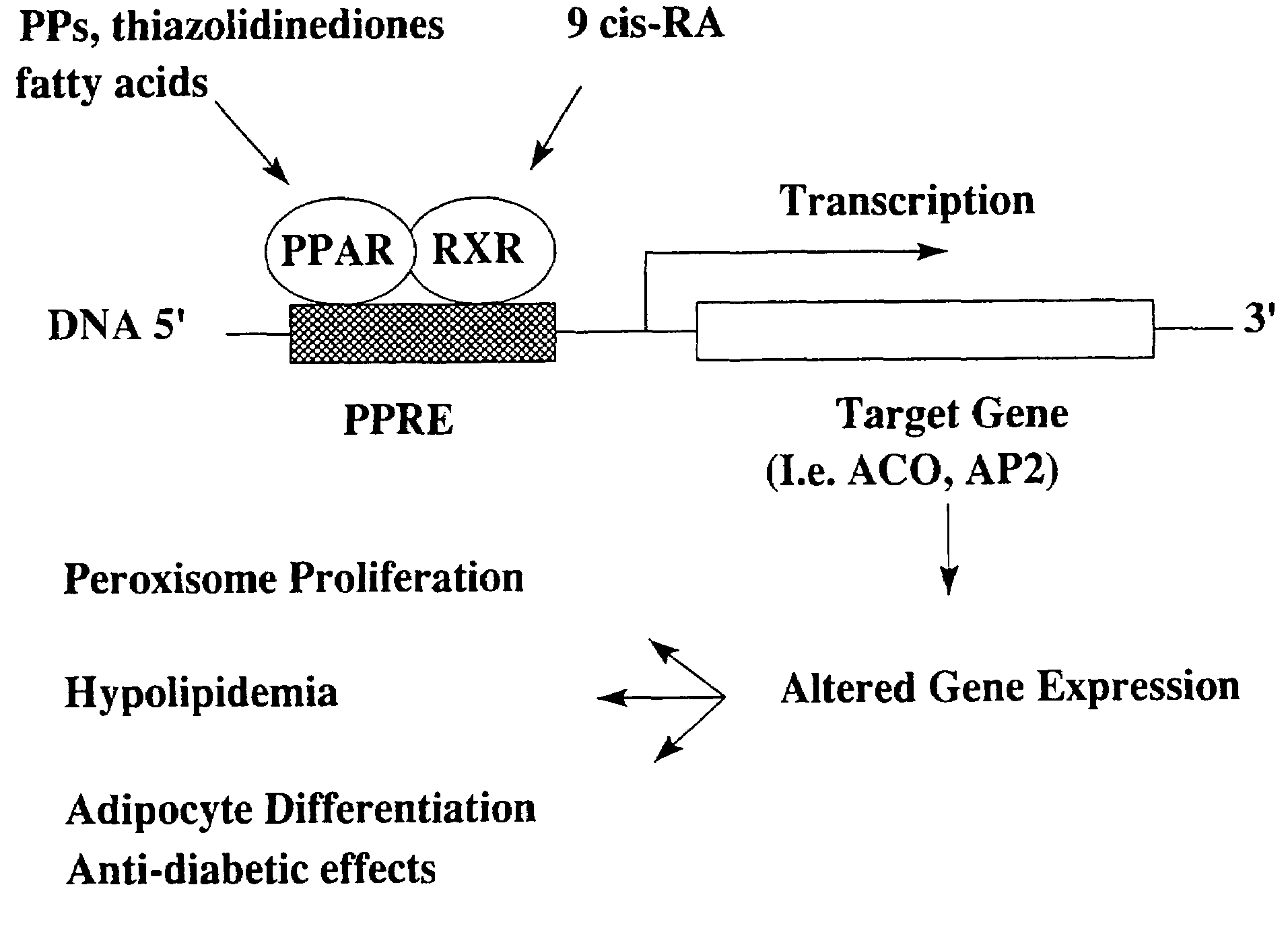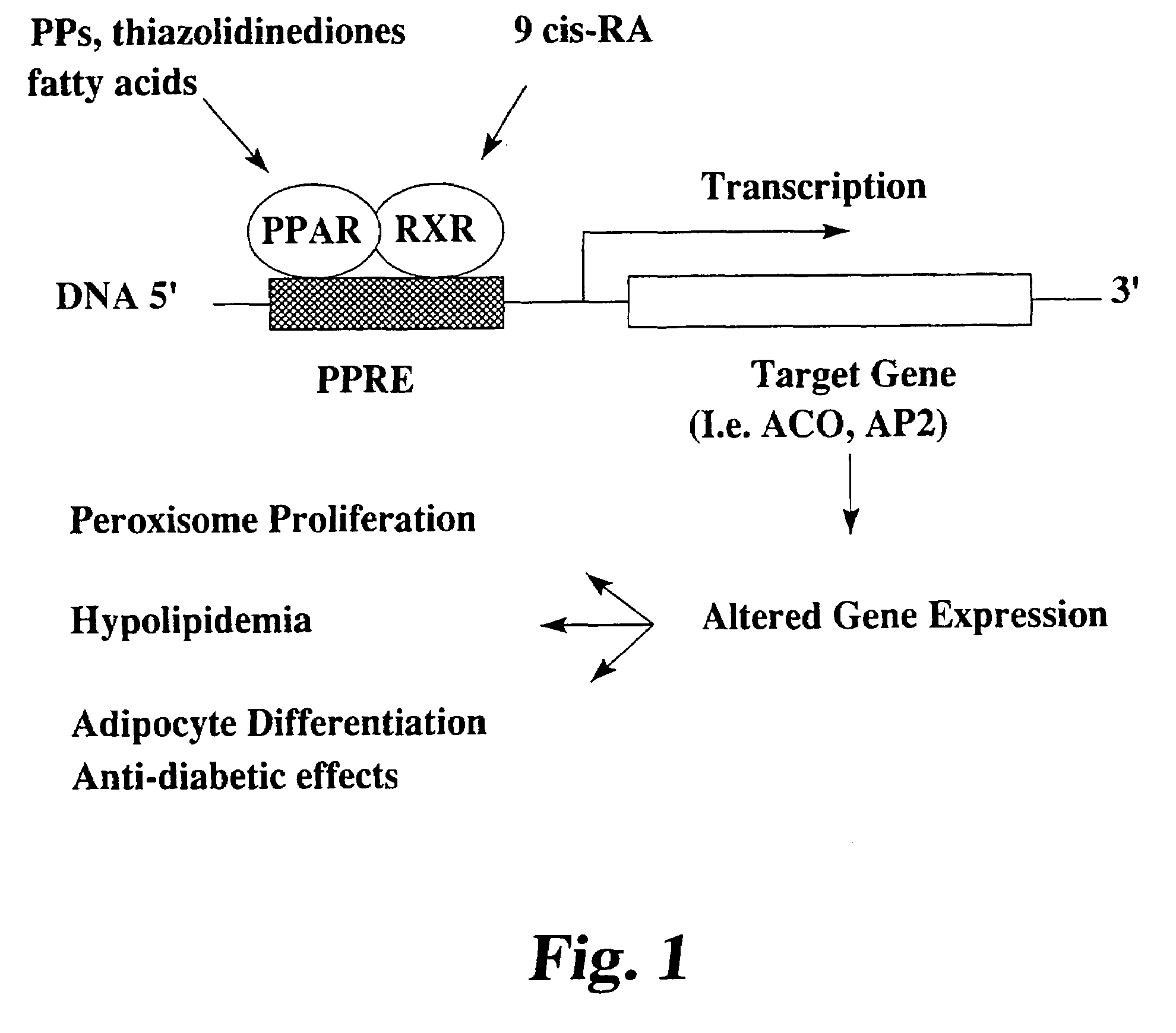Methods and compositions for treating diabetes
a technology of compositions and diabetes, applied in the field of diabetes treatment, can solve the problems of serious complications, toxic side effects of many of the known hypoglycemic agents
- Summary
- Abstract
- Description
- Claims
- Application Information
AI Technical Summary
Benefits of technology
Problems solved by technology
Method used
Image
Examples
example 1
Activation of Peroxisome Proliferator-Activated Receptor (PPAR) by CLA
[0034]In this example, CLA is shown to be involved in the activation of several PPAR subtypes. PPAR, an intracellular protein receptor, is a member of the steroid hormone superfamily that may be important in regulating the expression of lipid metabolism enzymes and may have an effect on cell growth and / or differentiation. Three subtypes of PPAR (α, β and γ) have been identified in several species, including human. PPARγ is thought to be involved in the anti-diabetic and glucose lowering activity of groups of drugs known as thiazolidinediones and fibrate hypolipidemic drugs. PPAR can be activated by peroxisome proliferators, thiazolidinediones and fatty acids. The mechanism of action of peroxisome proliferators is depicted in FIG. 1 and the effects of the activators of PPAR subtypes is shown in Table 1.
[0035]
TABLE 1Activators of PPAR subtypes and their effects.Drug / ChemicalGroupPPARαPPARβPPARγClinical Use or effect...
example 2
Activation of PPAR Subtypes by CLA Isomers
[0038]In this example, certain PPAR subtypes are shown to be activated by CLA isomers. The same experimental procedure as described in Example 1 was carried out to generate the data shown in FIG. 4. However, a 100 μM concentration of selected isomers of CLA were also utilized in the transfection assay to determine whether specific isomers of CLA could activate any of the PPAR subtypes.
[0039]The data in FIGS. 5–7 was generated utilizing constructs including full length mouse PPARα, PPARβ or PPARγ and a luciferase reporter gene. The CV-1 cell line (African green monkey kidney cells) used was obtained from American Type Culture Collection (#CCL-70). The cells were grown in Eagle minimal essential medium containing 10% fetal bovine serum (GIBCO). For each transfection involving PPARα, 625 ng pcDNA3-PPARα expression vector was used along with 250 ng of psV-GL-2-PPRE-luciferase reporter plasmid and 250 ng of pSV-β-galactosidase internal control pl...
example 3
Effect of CLA on Gene Expression
[0042]Activation of certain PPAR subtypes results in altered gene expression, such as gene induction. In this example, CLA was found to induce two markers of differentiation of mouse 3T3-L1 preadipocytes into differentiated adipocytes, which requires PPARγ activation. The two markers studied were adipocyte protein-2 (mAP2) mRNA and PPARγ mRNA.
3T3-L1 Cell Culture
[0043]Mouse 3T3-L1 preadipocytes (American Type Culture Collection) were maintained in Dulbecco's modified Eagle's medium (DMEM) supplemented with 10% fetal calf serum (Gibco BRL) 0.2 mg / ml streptomycin and 200 U / ml penicillin (“growth media”). Differentiation was induced as described by Brandes, R., Arad R., and Bar-Tana, J., Biochem. Pharmacol. 50, 1949–1951 (1995). Briefly, differentiation was induced by adding various concentrations of CLA (25–250 μM final concentration), linoleic acid (100 μM), Wy 14,643 (100 μM) or vehicle (DMSO) in DMEM with 10% FCS and 0.1 μM dexamethasone (“induction m...
PUM
| Property | Measurement | Unit |
|---|---|---|
| Body weight | aaaaa | aaaaa |
| Body weight | aaaaa | aaaaa |
| Pharmaceutically acceptable | aaaaa | aaaaa |
Abstract
Description
Claims
Application Information
 Login to View More
Login to View More - R&D
- Intellectual Property
- Life Sciences
- Materials
- Tech Scout
- Unparalleled Data Quality
- Higher Quality Content
- 60% Fewer Hallucinations
Browse by: Latest US Patents, China's latest patents, Technical Efficacy Thesaurus, Application Domain, Technology Topic, Popular Technical Reports.
© 2025 PatSnap. All rights reserved.Legal|Privacy policy|Modern Slavery Act Transparency Statement|Sitemap|About US| Contact US: help@patsnap.com



